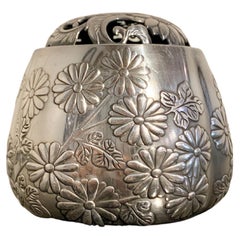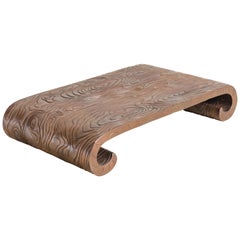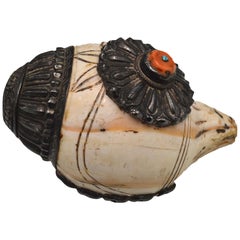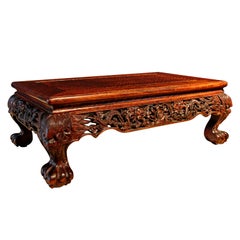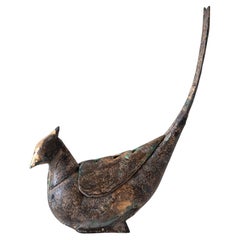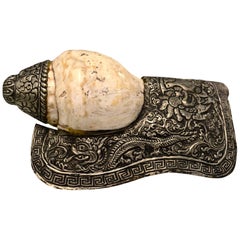Repoussé Scholar's Objects
to
3
2
1
1
1
1
1
1
3
2
1
1
1
2
2
1
1
3
3
3
1
Technique: Repoussé
Japanese Silver Incense Burner, Akoda Koro, by Nomura, Meiji Period, Japan
Located in Austin, TX
A lovely and luxurious Japanese silver incense burner of lobed melon form, akoda koro, marked jungin and signed Nomura, Meiji Period, circa 1900, Japan.
The silver koro...
Category
1910s Japanese Meiji Vintage Repoussé Scholar's Objects
Materials
Silver, Sterling Silver
Woodgrain Scroll Stand, Antique Copper by Robert Kuo, Hand Repousse, Limited
By Robert Kuo
Located in Los Angeles, CA
Woodgrain scroll stand
Antique copper
Hand repousse
Limited Edition
Repousse´ is the traditional art of hand-hammering decorative relief onto sheet metal. The technique origin...
Category
2010s Repoussé Scholar's Objects
Materials
Copper
Sacred Silver and Conch Shell Trumpet, Tibet, 19th Century
Located in San Pedro Garza Garcia, Nuevo Leon
Conch shell recipient and container for holy water used in ceremonies. Known as “Buddha ears”, they were mounted as a sound instrument. Such shells are important ritual objects in Tibetan Buddhism...
Category
19th Century Tibetan Tibetan Antique Repoussé Scholar's Objects
Materials
Silver
Related Items
Chinese Carved Longyan Wood Stand, Late Qing Dynasty
Located in Austin, TX
An exquisite late Qing dynasty display Stand of longyan wood, carved as a miniature "kang" table.
The center panel features an amazing grain that delights the eye, while a soft glo...
Category
Early 1900s Chinese Qing Antique Repoussé Scholar's Objects
Materials
Fruitwood
Japanese Iron Abstract Bird Incense Burner
Located in San Diego, CA
Iron bird sculpture with a nice patina and original box. Removable vented piece, for burning incense or flower arrangements, 1950s.
Category
1960s Japanese Mid-Century Modern Vintage Repoussé Scholar's Objects
Materials
Iron
Chinese Cloisonne Incense Tool Vase, Qing Dynasty, 18th/19th Century, China
Located in Austin, TX
A small and elegant Chinese cloisonné vase for incense tools, Qing Dynasty, 18th/19th century, China.
Made for the scholar's studio, this small refined vase, was used to hold incense tools, including a small pair of tongs or chopsticks and spoon. The tools no longer present.
Of miniature baluster vase form, the vase beautify proportioned and decorated in the cloisonné enamel technique, with gilt wires forming the cloisons, or partitions. Within the cloisons, colorful enamels have been expertly laid.
The small incense tool vase...
Category
Early 1800s Chinese Qing Antique Repoussé Scholar's Objects
Materials
Copper, Enamel
$6,800
H 3.75 in Dm 1.75 in
Japanese Iron Owl Incense Burner Lantern
Located in San Diego, CA
Iron owl sculpture with a nice patina. Removable head with vented ears and eyes. For burning incense, small lantern, or candle holder. Japan. 1960s.
Category
1960s Japanese Mid-Century Modern Vintage Repoussé Scholar's Objects
Materials
Iron
19th Century Chinese Carved Giltwood Panel
Located in San Diego, CA
Antique 19th century Chinese carved gold gilt and painted wood wall panel or plaque with scholar and warrior figures scene. Signed on back as p...
Category
19th Century Chinese Antique Repoussé Scholar's Objects
Japanese Silver Inlaid Bronze Incense Burner, 19th Century
Located in Toronto, CA
This is a wonderful Japanese, silver inlaid, solid Bronze incense burner from the late 19th century or early 20th century.
The removable lid features beautiful modelling of a small ...
Category
Late 19th Century Japanese Chinese Export Antique Repoussé Scholar's Objects
Materials
Silver, Bronze
Antique Meiji Japanese Cloisonne Enamel Dragon Censor Koro
Located in Long Island City, NY
An antique Japanese, late Meiji Era, tripod enamel censer koro. The sphere form ware is enameled with a polychrome image of a dragon on a black ground made in the Cloisonne technique...
Category
Late 19th Century Japanese Meiji Antique Repoussé Scholar's Objects
Materials
Enamel
Late Edo Period Horagai Conch Shell Trumpet
Located in Fukuoka, JP
Horagai conch shell trumpet with beautiful patination and bronze mouthpiece.
This Horagai conch shell trumpet is a rare and valuable piece of Japanese history and culture. It was made in the Late Edo period (18th-19th century) and is in fine original condition with expected abrasions due to the significant age of the item. The trumpet is made of a conch shell with a bronze mouthpiece. It measures 34x 16.5 x 13 cm (13.5 / 6.5 / 5 inch) and weighs 1.2kg (2.5 lb).
The trumpet has a beautiful patina, resulting from years of use and exposure to the elements. The bronze mouthpiece is also in good condition and shows no signs of wear. The trumpet is powerful and can produce a loud, clear sound. It was traditionally used in Japanese ceremonies and festivals and is still used today by some Shinto priests...
Category
19th Century Japanese Edo Antique Repoussé Scholar's Objects
Materials
Shell
Japanese Iron Bird Incense Burner
Located in San Diego, CA
Vintage Japanese iron bird incense burner, circa 1960s. The piece has a removable vented piece for burning incense, a wonderful patina and measures 6.5"...
Category
Mid-20th Century Japanese Mid-Century Modern Repoussé Scholar's Objects
Materials
Iron
Antique 19th Century Southeast Asian Cast Bronze Buddha Statue Sculpture 1800
Located in Portland, OR
A good antique Early 19th Century Southeast Asian Bronze Buddha statue, Circa 1800.
The Buddha seated upon a triangular shaped base with lotus decoration, the Buddha's hands posed i...
Category
19th Century Tibetan Tibetan Antique Repoussé Scholar's Objects
Materials
Bronze
$800
H 6.75 in W 4.75 in D 2.75 in
Finely Carved Japanese Okimono on Stand
Located in Atlanta, GA
An antique Okimono (Japanese means artsy display ornament object) displayed on a small custom wood stand from Meiji Period circa early 2oth century. T...
Category
Early 20th Century Japanese Japonisme Repoussé Scholar's Objects
Materials
Wood
19th C Pair Antique Chinese Qing Carved Jade Scholar's Table Screens Stands 1850
Located in Portland, OR
A fine pair of antique Chinese Qing dynasty ( 1644-1911) hand carved jade table screens, circa 1850.
The rectangular screens are made of variegated s...
Category
1850s Chinese Qing Antique Repoussé Scholar's Objects
Materials
Jade
$1,750 / set
H 11 in W 10 in D 3.25 in
Previously Available Items
Sacred Silver and Conch Shell Trumpet, Tibet, 19th Century
Located in San Pedro Garza Garcia, Nuevo Leon
Tibetan silver and conch shell recipient and container for Holy Water used in ceremonies. All conch shell trumpets, in the Tibetan-Buddhist tradition, are referred to as dung dkar. T...
Category
19th Century Tibetan Tibetan Antique Repoussé Scholar's Objects
Materials
Silver
Recently Viewed
View AllMore Ways To Browse
Antique Chinese Brush Holder
Qing Ink Stone
Vintage Paint Brush Horse Hair
Antique Chinese Carved Bamboo Brush Pot
Antique Chinese Snuff Bottles Inside Painted
Jade Archer
Calligraphy Brush Stand
Jade Archer Ring
Bamboo Brush Holder
Chinese Calligraphy Brush And Stand
Chinese Wood Carvings Bamboo Brush Pots
Conch Trumpet
Gourd Snuff Bottle
Jade Brush Washer
Antique Chinese Jade Brush Washer
Antique Chinese Libation Cup
Duan Stone
Duan Inkstone
